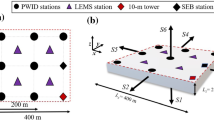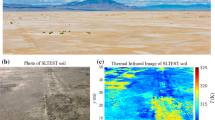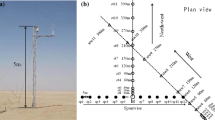Abstract
It has been noted that when the convective Richardson numberRi* is used to characterize the depth of the entrainment zone, various parameterization schemes can be obtained. This situation is often attributed to the invalidity of parcel theory. However, evidence shows that the convective Richardson numberRi* might be an improper characteristic scaling parameter for the entrainment process. An attempt to use an innovative parameter to parameterize the entrainment-zone thickness has been made in this paper. Based on the examination of the data of water-tank experiments and atmospheric measurements, it is found that the total lapse rate of potential temperature across the entrainment zone is proportional to that of the capping inversion layer. Inserting this relationship into the so-called parcel theory, it thus gives a new parameterization scheme for the depth of the entrainment zone. This scheme includes the lapse rate of the capping inversion layer that plays an important role in the entrainment process. Its physical representation is reasonable. The new scheme gives a better ordering of the data measured in both water-tank and atmosphere as compared with the traditional method usingRi*. These indicate that the parcel theory can describe the entrainment process suitably and that the new parameter is better thanRi*.
Similar content being viewed by others
References
Angevine, W. M., A. B. White, and S. K. Avery, 1994: Boundary-layer depth and entrainment zone characterization with a boundary-layer profiler.Bound.-Layer Meteor.,68, 375–385.
Betts, A. K., 1976: Modeling subcloud layer structure and interaction with a shallow cumulus layer.J. Atmos. Sci.,33, 2326–2382.
Beyrich, F., and S. E. Gryning, 1998: Estimation of the entrainment zone depth in a shallow convective boundary layer from sodar data.J. Appl. Meteor.,37, 255–268.
Boers, R. A., 1989: A parameterization of the depth of the entrainment zone.J. Appl. Meteor.,28, 107–111.
Boers, R. A., and E. W. Eloranta, 1986: Lidar measurements of the atmospheric entrainment zone and the potential temperature jump across the top of the mixed layer.Bound.-Layer Meteor.,34, 357–375.
Crum, T. D., R. B. Stull, and E. W. Eloranta, 1987: Coincident lidar and aircraft observations of entrainment into thermals and mixed layer.J. Climate Appl. Meteor.,26, 774–788.
Deardorff, J. W., 1979: Prediction of convective mixed layer entrainment for realistic capping inversion structure.J. Atmos. Sci.,27, 1211–1213.
Deardorff, J. W., 1983: A multilimit mixed layer entrainment formulation.J. Phys. Oceanogr.,13, 988–1002.
Deardorff, J. W., G. E. Willis, and B. H. Stockton, 1980: Laboratory studies of the entrainment zone of a convectively mixed layer.J. Fluid Mech.,100, 41–64.
Gryning, S. E., and E. Batchvarova, 1994: Parameterization of the depth of the entrainment zone above the daytime mixed layer.Quart. J. Roy. Meteor. Soc.,120, 47–58.
Hageli, P., D. G. Steyn, and K. B. Strawbridge, 1993: Spatial and temporal variability of mixed-layer depth and entrainment zone thickness.Bound.-Layer Meteor.,97, 47–71.
Kim, S. W., S. U. Park, and C. H. Moeng, 2003: Entrainment process in the convective boundary layer with varying wind shear.Bound.-Layer Meteor.,108, 221–245.
Li Pingyang, Jiang Weimei, Sun Jianning, and Yuan Renmin, 2003: A laboratory modeling of the velocity field in the convective boundary with the particle image velocimetry technique.Adv. Atmos. Sci.,20(4), 631–637.
Mahrt, L., 1979: Penetrative convection at the top of a growing boundary layer.Quart. J. Roy. Meteor, Soc.,105, 469–485.
Nelson, E., R. B. Stull, and E. W. Eloranta, 1989: A prognostic relationship for entrainment zone thickness.J. Appl. Meteor.,28, 885–902.
Sorbjan, Z., 1990: Similarity scales and universal profiles of statistical moments in the convective boundary layer.J. Appl. Meteor.,29, 762–775.
Stull, R. B., 1973: Inversion rise model based on penetrative convection.J. Atmos. Sci.,30, 1092–1099.
Stull, R. B., and E. W. Eloranta, 1984: Boundary layer experiment 1983.Bull. Amer. Meteor. Soc.,65, 450–456.
Zeman, O., and H. Tennedes, 1977: Parameterization of the turbulent energy budget at the top of the day-time atmospheric boundary layer.J. Atmos. Sci.,34, 111–123.
Author information
Authors and Affiliations
Corresponding author
Rights and permissions
About this article
Cite this article
Jianning, S., Weimei, J., Ziyun, C. et al. Parameterization for the depth of the entrainment zone above the convectively mixed layer. Adv. Atmos. Sci. 22, 114–121 (2005). https://doi.org/10.1007/BF02930874
Received:
Revised:
Issue Date:
DOI: https://doi.org/10.1007/BF02930874




